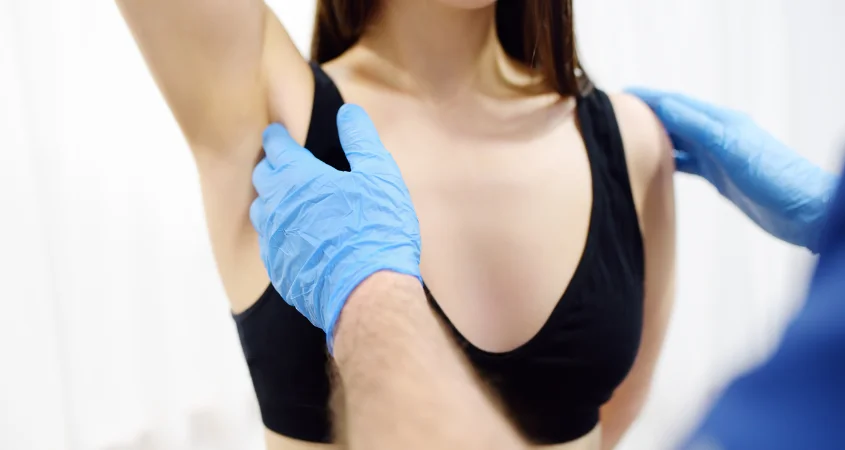What is Subfascial Breast Augmentation and Its Alternatives
By Partington Plastic Surgery on February 23, 2024 in Breast Augmentation

Understanding Subfascial Breast Augmentation
Definition of Subfascial Breast Augmentation
In subfascial breast augmentation, the breast implant is placed beneath the pectoralis major muscle’s fascia in cosmetic and plastic surgery procedures. Capsular contracture and implant misplacement are less common when the subfascial plane provides a stable environment for the implant. Furthermore, this technique may result in less pain following surgery and quicker recovery times than submuscular insertion, making it a better option for some patient types.
How the Procedure is Performed
The benefits of subfascial breast augmentation, both anatomically and aesthetically, are making the procedure more and more popular. It entails positioning the implant beneath the pectoral muscular fascia. The procedure begins with a very small incision, usually made in the inframammary fold, to minimize visible scarring.
Following the incision, the surgeon carefully creates a gap beneath the thin, strong connective tissue, which is situated above the pectoral muscle. After that, the implant is placed.
This placement of the implant reduces the likelihood of moving and obvious wrinkling by offering better reinforcement and a more realistic contour. Additionally, as the muscle integrity is mostly preserved, the subfascial technique may result in less discomfort following surgery than submuscular insertion.
Benefits of Subfascial Breast Augmentation
Aesthetic Benefits
Subfascial breast augmentation improves the natural contour and reduces issues, which results in a noticeable visual benefit. By using this method, the breast implant is positioned beneath the layer of fibrous tissue that covers the pectoral muscles, or fascia. This method lessens the visibility of the implant edges and ensures optimum implant coverage.

By integrating the implant with the chest wall more smoothly and seamlessly, this technique reduces the likelihood of rippling and palpability while simultaneously maintaining the visual appeal of the upper pole fullness.
Furthermore, problems like as capsular contracture and aberrant motion that are frequently associated with submuscular breast augmentations might be lessened by positioning the implant in the subfascial position.
Faster Recovery Time
Compared to earlier techniques, subfascial breast augmentation offers a number of distinct advantages, particularly with regard to recovery time. Through the insertion of the implant below the fascia, the layer of connective tissue covering the muscle, the benefits of both subglandular and submuscular placements are combined, while the drawbacks of each technique are minimized.
Muscle spasms and postoperative discomfort are significantly reduced by subfascial placement, which significantly reduces interference with the pectoral muscle. Patients so benefit from a much-shortened recovery period, which enables them to quickly resume their regular activities.
Furthermore, by lowering the likelihood of issues such as capsular contracture and aberrant animation, the subfascial breast augmentation work and technique enhances patient outcomes and satisfaction. Subfascial breast augmentation is becoming more and more popular among plastic surgeons and medical researchers because of its advantages, which make it an effective way to achieve optimal aesthetic outcomes with a short recovery period.
Natural Look
Confident Beauty
24 Hour Rapid Recovery, Muscle Sparing.

Potential Drawbacks of Subfascial Breast Augmentation
Technical Complexity
Due to its technical complexity, subfascial breast augmentation surgery has a number of potential drawbacks. With this technique, the implant must be placed beneath the pectoral muscle’s fascia, which calls for a high level of surgical precision and competence.

The possibility of issues such as asymmetry, improper implant placement, and protracted healing times is increased by the treatment’s complexity. Furthermore, the necessity of careful fascial plane manipulation and dissection may lengthen surgical procedures and raise the risk of bleeding during the process.
Plastic surgeons alike need to be aware of these technological obstacles in order to improve patient outcomes and minimize adverse effects associated with subfascial breast augmentation.
Limited Surgeons Specializing in Technique
Subfascial breast augmentation has benefits including less visible implants, breast lift and increased upper pole fullness. One significant problem is the dearth of surgeons skilled in this specific surgery, which can lead to a number of challenges.
Accurately applying the subfascial approach requires specialized knowledge and training that is not widely available. Because of this, patients can have trouble finding qualified surgeons, which could result in less-than-ideal outcomes and a higher risk of complications.
This restriction emphasizes the necessity of ongoing education and training for the industry in order to grow the pool of qualified professionals who are capable of doing subfascial breast augmentations in a safe manner.
Potential for Specific Complications
Despite its alluring advantages, subfascial breast augmentation may have drawbacks that should be carefully considered. The increased risk of implant displacement resulting from the relatively shallow setting below the fascia but above the muscle is a crucial factor to take into account.
This placement of the implant may lead to more noticeable implant edges and an increased risk of capsular contracture, which is the hardening and distortion of the breast form as a result of scar tissue developing around the implant. Furthermore, the implantation of subfascial implants may impede the clarity of mammography images by obscuring breast tissue, which would make cancer detection more challenging.
When choosing the best surgical technique, medical professionals must carefully consider these possible risks in the context of each patient’s unique traits, striking a balance between the desired cosmetic outcome and long-term health consequences.
Comparing Subfascial Breast Augmentation to Other Techniques
Subglandular Breast Augmentation
Subglandular, the technique is usually a better option. The implant is positioned precisely beneath the breast tissue, but above the pectoral muscle, in the subglandular surgery.
By reducing the complexity and the challenges related to muscle manipulation, this typically results most patients, in shorter operating durations and a lower risk of intraoperative bleeding. Furthermore, because subglandular augmentation does not damage the pectoral muscle, patients usually recover more quickly and have less pain following surgery.

An additional benefit of the subglandular operation is its remarkable aesthetic impact, particularly for patients who wish to have noticeable fullness in the upper portion of their breasts. For patients with enough breast tissue, the implant can provide a more natural appearance and feel since it is placed directly under the breast tissue, which lessens the possibility of visible implant borders and rippling.
Conversely, the subfascial method has trouble generating smooth cosmetic transitions, especially in individuals with insufficient natural breast tissue, even while it lessens some of the drawbacks of submuscular insertion.
Therefore, for some individuals and under some circumstances, the subglandular approach might be a less complicated and more effective way to achieve the desired, cosmetic effects faster.
Submuscular Breast Augmentation
Submuscular augmentation involves directly placing the implant beneath the pectoral muscle. As pectoral muscle is not hampered, placing the implant below the fascia usually results in less pain following surgery and a speedier recovery period.
Still, in patients with less breast tissue, it might be less effective in covering the implant, which could lead to more noticeable implant margins. For many patients with thin breast tissue, submuscular augmentation offers better implant coverage and a more natural appearance. It’s a procedure that hurts more and takes longer to heal.
Cost Considerations
A common argument for subfascial augmentation is that it is an affordable option that strikes a compromise between high and cheap costs. The relatively greater expense of this approach can be attributed to the lengthier duration of the surgery and the requirement for specialized expertise compared to subglandular therapies.
Because of how complicated the procedure is and how long recovery takes, submuscular augmentation is usually the most expensive choice. This method, which places the implant beneath the pectoral muscle, requires a high degree of surgical skill and typically results in longer operating hours and greater anesthesia costs.
Because of its relative simplicity and shorter operating period, the subglandular technique is usually more cost-effective. This approach typically removes the need for significant muscle manipulation, which lowers the cost of surgery.
Subglandular augmentation surgery usually has a price tag of $5,000 to $7,500. Numerous variables, such as the kind of implant utilized, the surgeon’s level of expertise, and any extra facility costs, affect the total cost.

Patients ultimately need to consider aesthetic goals, possible risks, and personal compatibility of each approach in addition to cost. To make an informed decision that considers the cost, desired outcomes, and individual health factors, consulting a board-certified plastic surgeon can provide insightful information.
Conclusion
In summary, choosing the right type of breast augmentation — subfascial, submuscular, or subglandular — requires carefully weighing a number of factors, such as desired results, procedural complexity, recovery times, and costs.
Each operation has unique advantages and potential drawbacks, which emphasizes how crucial it is for patients to be able to have in-depth conversations with plastic surgeons who are certified by an organization.
These discussions can help clarify how each treatment relates to the patient’s unique anatomy, health issues, and desired outcomes. By carefully weighing the tiny differences between each traditional breast augmentation technique, patients can make well-informed decisions. This enables patients to balance their long-term health and well-being with their desire for an enlargement that looks natural.
Return to Overview
